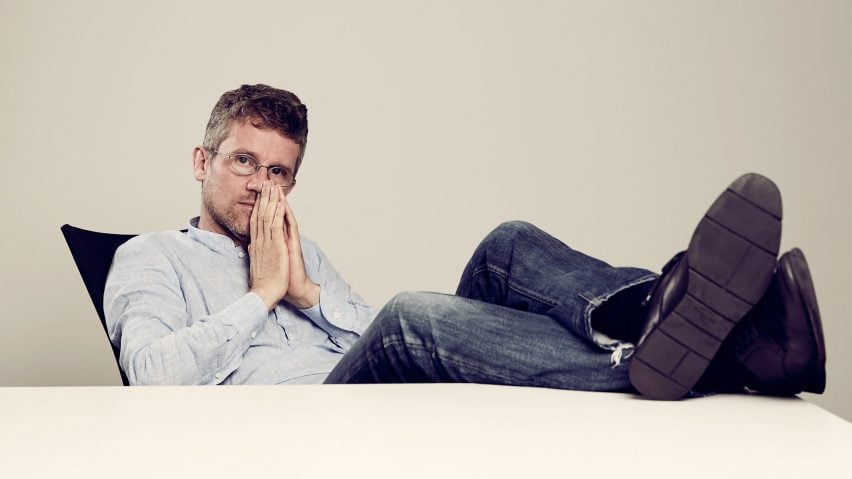Hospitals and universities are "dinosaurs" that need to be redesigned in the wake of coronavirus, according to architect Carlo Ratti.
"I think we got two kinds of dinosaurs in society today," Ratti told Dezeen in a live interview last week as part of Virtual Design Festival.
Hospitals are "this kind of centralised machine where you get out sicker than when you go in," he said. "Redesigning the interface with the medical system is going to be very, very important."
"We need to reinvent the university system"
"And the other dinosaurs are universities," said Ratti, who directs the Senseable City Lab at Massachusetts Institute of Technology and is founder of architecture studio Carlo Ratti Associati.
"I'm telling you this as someone who's been involved with universities all my life, but I think we need to reinvent the university system."
Ratti made the comments after giving a short presentation of recent projects including Cura, a pop-up intensive care unit made of shipping containers. First unveiled in March, a prototype was installed at a hospital in Turin, Italy, last month.
Ratti claimed that Cura was a better solution than turning convention centres and other large buildings into temporary hospitals for coronavirus patients.
Ratti's intensive care unit controls air flow
Patients with infectious respiratory diseases such as coronavirus can be treated in negative-pressure environments, which prevent virus particles from escaping. However, this is hard to achieve in large, open-plan interiors.
"The way the people have been doing [temporary] intensive care units [for coronavirus patients] is mostly to take a big convention center and turn it into a makeshift hospital," Ratti said.
"However, one of the issues is that you get a lot of contamination of the air," he added. "You cannot do biocontainment. That's why we saw so many healthcare professionals who got sick. To do negative pressure you need a box."
Ratti's Cura solution uses shipping containers to create individual intensive care units that can easily be sealed to create the negative pressure needed for biocontainment. The containers can then rapidly be moved to different locations according to need.
"Containers are all over the world, we can move them very quickly," said Ratti. "So we can fit them with negative pressure. They can be pre-assembled with all the medical things so we can move them from one city to another city."
Containers "ideally suited for this"
Ratti defended his decision to use containers, which have been getting a bad press recently due to their widespread use in architecture projects despite being ill-suited to many applications.
Containers are "almost like ideally suited for this," he said. "If you'd asked me last year if I would ever do a container project, I would say no. But in this case, it makes sense."
"People think this is another student project, you know, an architecture second-year architecture student project," he added. "But you know, even the most trite solution can sometimes also be the right one."
Last month Dr Sam Smith told Dezeen that hospitals "desperately need designers" to improve equipment and services. "We need designers at every turn, but they are so infrequently consulted," said Smith, a clinical physician at Massachusetts General Hospital in Boston.
"In the end, most physicians burn out early because, in part, we are lacking well designed cognitive and physical spaces to help process the information smoothly."
Universities are "too expensive"
Universities similarly need to be radically rethought, Ratti said. With campuses shut down due to the pandemic, teaching has moved online.
"This has forced a lot of people to fully embrace digital and it can even be better for giving feedback to students," the Italian architect said, adding that the traditional university campus could be replaced by smaller physical hubs for students and teachers to meet in person, with most lessons conducted digitally.
"The reason I'm saying that it's a dinosaur is that it's too expensive, especially in the United States," he said. "We cannot continue this way. We can find a better way to get maybe not a hundred per cent by 95 per cent of what an amazing Ivy League education is today, but for 10 per cent of the cost."
Universities have changed little since the first one was founded in Bologna in 1088, Ratti said. "I think there's something magic about campuses," Ratti added, saying they would never completely be replaced by digital solutions due to the importance of chance encounters that can only happen in the physical world.
"Serendipity will still need us to create these kinds of places where we can come up with new ideas that we're not looking for," he said. "But maybe not all the students and all the professors need to be in Cambridge [where MIT is based] all the same time."
"Maybe we'll be able to share knowledge in a different way."

